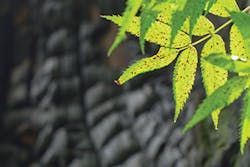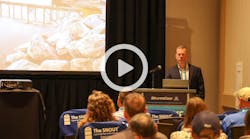When Vince Morris, president of Ertec, walked out into what used to be the beautiful community of formerly stately homes and forested lots in Running Springs, CA, shortly after the San Bernardino fires in 2007, thescene was almost surreal. “It was like a moonscape,” he says. Some of the trees, charred though they were, were still there, “but everything else was gone. On one block all of the houses were gone except for one—it was untouched and the homeowner was out there watering his lawn, trimming his roses; his entire property was intact. Pretty much everything else was down to the foundations. Vegetation was completely gone—lots of potential for loss of soil. It was a pretty vast area.”
Mike Alberson, currently stormwater program manager for southwest divisions for Apex Companies, was hired by San Bernardino County to develop stormwater pollution prevention plans for Running Springs after the fire. He marvels at the energy released during the fire. “It’s hard to believe how hot it can be. It would take a copper pipe and melt it down into a puddle,” he says.
According to the San Diego Wildfires Education Project, before the 2007 fires in southern California were brought under control, 7,344 separate fires had burned 370,998 acres. While some fires were caused by nature, others were man-made. According to Alberson, the San Bernardino fire was both: a lightning strike to malfunctioning power infrastructure set the spark.
After such a wave of destruction, says Morris, on average, first-year post-fire watershed sediment yield is 35 times greater than that from comparable unburned areas.
Clearing and Cleaning
Before replanting the site could even be considered the first priority was cleanup. “When you first get into it, you’re dealing with so much hazmat material. We were there to make sure to control the stormwater aspect,” says Alberson. Hazardous materials come from the homes, vehicles, and the residue of household chemicals and combusted building materials, all of which needed to be contained and removed along with the surface layer of any impacted or contaminated soils. After testing the soil for hazards such as arsenic and asbestos, and hauling away the most offensive material to hazardous waste disposal sites, restoration workers could operate safe from contamination. Alberson says the first order of business was installation of perimeter controls.
“The original specs called for silt fences. We were thinking of something maybe of a little higher grade; they didn’t want to do that, so we had the erosion control company put in regular silt fence. It was in about a week, and, lo and behold, we got about a 3-foot snow. There had been close to 5,000 linear feet [of fence] that had been installed, and every bit of it went on the ground,” says Alberson. “So they said, ‘Well, that didn’t work. What do you think we can do?’”
On the steep slopes, says Alberson, the silt fence could just as easily have been blown out by rainwater build up behind the fences during a heavy rainstorm, allowing water loaded with sediment and ash to pollute nearby streams.
He had heard of Ertec’s product, the S-Fence, but had not yet used it on a project. “Fish and Game had been telling us this BMP is going to have to be here long-term—up to five years to help reestablish the situation,” he recalls. He says durability is one of the attributes of the S-Fence that Ertec highlights, so he “decided to start with a small quantity to see how it would work out.”
Not being familiar with the product, he brought in about 10,000 linear feet and experimented with a few different installation techniques, from hog ties to staples. “The best way was to attach a stake with a drywall screw with a 2-inch overlap at each end and a stake in the middle,” he says. “So you took fewer stakes than a wattle, and it was easier to install than a silt fence.”
San Bernardino County eventually purchased about 50,000 linear feet of Ertec’s 10-inch S-Fence for the project. It was trenched in to a depth of 3 inches in areas where concentrated flow was expected. As homeowners stabilized their lots, the S-Fence was removed and relocated. “We would install the product; they would go in and clean up the area and as they finished it we stabilized it by using a native seed approved by Fish and Game. We would spray it all with [Profile Products’] Flexterra, and pack it, and once the plants started growing we would remove the temporary BMPs and move on to the next site. We took that 50,000 linear feet and used it enough times to cover 250,000—we used it four times or five times.” Alberson says the project spanned about a year and eight months, and when it was completed, there was product left over for possible reuse yet again. “Some of the S-Fence is still on the mountain—in those areas where Fish and Game said we had to leave it—and some of the product is back in the warehouse with San Bernardino County.”
Along with the S-Fence for perimeter control, says Alberson, “We used a lot of Flexterra, we used a lot of mulch as well—they had lost so many trees on the mountain that they were grinding up the burnt trees and spreading that and using it for mulch.” But because of the sheer number of trees that were being ground up, the mulch “got so thick in some areas, as much as four to six feet deep, that it caught fire from the self-generated heat in the pile.” Although these fires were relatively small, says Alberson, once they were extinguished, “we decided that rather than using the mulch they were making from burnt trees, we would just spray it. They’d had enough of fires at that point.”


